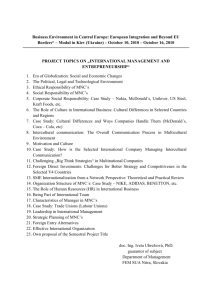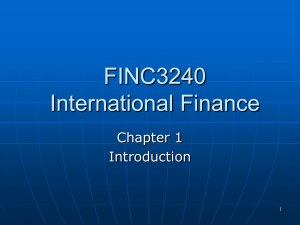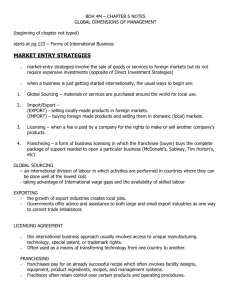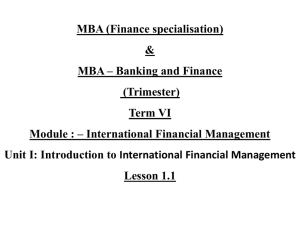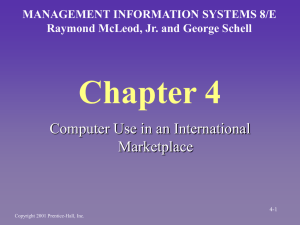Chapter 1
advertisement
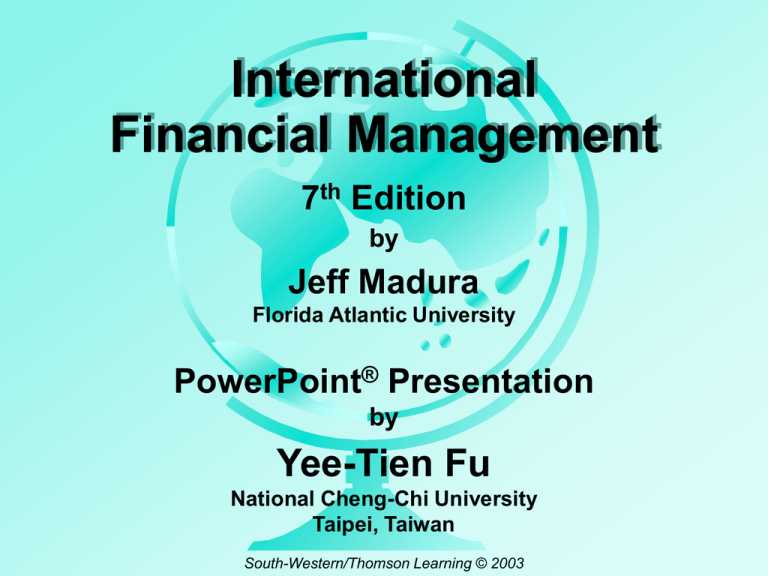
International Financial Management 7th Edition by Jeff Madura Florida Atlantic University PowerPoint® Presentation by Yee-Tien Fu National Cheng-Chi University Taipei, Taiwan South-Western/Thomson Learning © 2003 Part I The International Financial Environment Multinational Corporation (MNC) Foreign Exchange Markets Exporting & Importing Product Markets Dividend Remittance & Financing Subsidiaries Investing & Financing International Financial Markets Chapter 1 Multinational Financial Management: An Overview South-Western/Thomson Learning © 2003 Chapter Objectives • To identify the main goal of the multinational corporation (MNC) and conflicts with that goal; • To describe the key theories that justify international business; and • To explain the common methods used to conduct international business. C1 - 4 Goal of the MNC • The commonly accepted goal of an MNC is to maximize shareholder wealth. • We will focus on MNCs that are based in the United States and that wholly own their foreign subsidiaries. C1 - 5 Conflicts Against the MNC Goal • For corporations with shareholders who differ from their managers, a conflict of goals can exist - the agency problem. • Agency costs are normally larger for MNCs than for purely domestic firms. ¤ The sheer size of the MNC. ¤ The scattering of distant subsidiaries. ¤ The culture of foreign managers. ¤ Subsidiary value versus overall MNC value. C1 - 6 Impact of Management Control • The magnitude of agency costs can vary with the management style of the MNC. • A centralized management style reduces agency costs. However, a decentralized style gives more control to those managers who are closer to the subsidiary’s operations and environment. C1 - 7 Centralized Multinational Financial Management for an MNC with two subsidiaries, A and B Cash Management at A Inventory and Accounts Receivable Management at A Financing at A Capital Expenditures at A Financial Managers of Parent Cash Management at B Inventory and Accounts Receivable Management at B Financing at B Capital Expenditures at B C1 - 8 Decentralized Multinational Financial Management for an MNC with two subsidiaries, A and B Cash Management at A Financial Managers of A Inventory and Accounts Receivable Management at A Financing at A Capital Expenditures at A Financial Managers of B Cash Management at B Inventory and Accounts Receivable Management at B Financing at B Capital Expenditures at B C1 - 9 Impact of Management Control • Some MNCs attempt to strike a balance they allow subsidiary managers to make the key decisions for their respective operations, but the decisions are monitored by the parent’s management. C1 - 10 Impact of Management Control • Electronic networks make it easier for the parent to monitor the actions and performance of foreign subsidiaries. • For example, corporate intranet or internet email facilitates communication. Financial reports and other documents can be sent electronically too. C1 - 11 Impact of Corporate Control • Various forms of corporate control can reduce agency costs. ¤ Stock compensation for board members and executives. ¤ The threat of a hostile takeover. ¤ Monitoring and intervention by large shareholders. C1 - 12 Constraints Interfering with the MNC’s Goal • As MNC managers attempt to maximize their firm’s value, they may be confronted with various constraints. ¤ Environmental constraints. ¤ Regulatory constraints. ¤ Ethical constraints. C1 - 13 Theories of International Business Why are firms motivated to expand their business internationally? Theory of Comparative Advantage ¤ Specialization by countries can increase production efficiency. Imperfect Markets Theory ¤ The markets for the various resources used in production are “imperfect.” C1 - 14 Theories of International Business Why are firms motivated to expand their business internationally? Product Cycle Theory ¤ As a firm matures, it may recognize additional opportunities outside its home country. C1 - 15 The International Product Life Cycle Firm creates product to accommodate local demand. a. Firm differentiates product from competitors and/or expands product line in foreign country. Firm exports product to accommodate foreign demand. or b. Firm’s foreign business declines as its competitive advantages are eliminated. Firm establishes foreign subsidiary to establish presence in foreign country and possibly to reduce costs. C1 - 16 International Business Methods There are several methods by which firms can conduct international business. • International trade is a relatively conservative approach involving exporting and/or importing. ¤ The internet facilitates international trade by enabling firms to advertise and manage orders through their websites. C1 - 17 International Business Methods • Licensing allows a firm to provide its technology in exchange for fees or some other benefits. • Franchising obligates a firm to provide a specialized sales or service strategy, support assistance, and possibly an initial investment in the franchise in exchange for periodic fees. C1 - 18 International Business Methods • Firms may also penetrate foreign markets by engaging in a joint venture (joint ownership and operation) with firms that reside in those markets. • Acquisitions of existing operations in foreign countries allow firms to quickly gain control over foreign operations as well as a share of the foreign market. C1 - 19 International Business Methods • Firms can also penetrate foreign markets by establishing new foreign subsidiaries. • In general, any method of conducting business that requires a direct investment in foreign operations is referred to as a direct foreign investment (DFI). • The optimal international business method may depend on the characteristics of the MNC. C1 - 20 Degree of International Business by MNCs Foreign Sales as a % of Total Sales Foreign Assets as a % of Total Assets 70% 62% 60% 46% 50% 66% 58% 50% 40% 33% 40% 30% 20% 47% 26% 12% 10% 0% Campbell's Dow Soup Chemical IBM Motorola Nike C1 - 21 Online Application • Check out the following international trade promotion sites. C1 - 22 http://www.tradenet.gov C1 - 23 http://www.business.gov/busadv/ index.cfm C1 - 24 http://www.trade.gov http://www.export.gov C1 - 25 International Opportunities • Investment opportunities - The marginal return on projects for an MNC is above that of a purely domestic firm because of the expanded opportunity set of possible projects from which to select. • Financing opportunities - An MNC is also able to obtain capital funding at a lower cost due to its larger opportunity set of funding sources around the world. C1 - 26 International Opportunities Cost-benefit Evaluation for Purely Domestic Firms versus MNCs Purely Domestic Firm Investment Opportunities Marginal Return on Projects Marginal Cost of Capital MNC MNC Purely Domestic Firm Financing Opportunities Appropriate Size for Purely Domestic Firm X Appropriate Size for MNC Y Asset Level of Firm C1 - 27 International Opportunities • Opportunities in Europe ¤ ¤ ¤ The Single European Act of 1987. The removal of the Berlin Wall in 1989. The inception of the euro in 1999. • Opportunities in Latin America ¤ ¤ The North American Free Trade Agreement (NAFTA) of 1993. The General Agreement on Tariffs and Trade (GATT) accord. C1 - 28 International Opportunities • Opportunities in Asia ¤ ¤ ¤ The reduction of investment restrictions by many Asian countries during the 1990s. China’s potential for growth. The Asian economic crisis in 1997-1998. C1 - 29 Online Application • For more information on the Asian crisis, check out the following sites: ¤ http://www.stern.nyu.edu/~nroubini/asia/Asi aHomepage.html ¤ http://www.asienhaus.org/navigat/english/a sienhau.htm C1 - 30 Exposure to International Risk International business usually increases an MNC’s exposure to: exchange rate movements ¤ Exchange rate fluctuations affect cash flows and foreign demand. foreign economies ¤ Economic conditions affect demand. political risk ¤ Political actions affect cash flows. C1 - 31 Exposure to International Risk U.S. Firm’s Cost of Obtaining £100,000 $165,000 $160,000 $155,000 $150,000 $145,000 $140,000 $135,000 $130,000 Jan 2000 Mar May Jul Sep Nov Jan Mar May 2001 C1 - 32 Online Application • Visit FRED®, Fed's economic time-series database, at http://www.stls.frb.org/fred for numerous economic and financial time series, e.g., balance of payment statistics, interest rates, foreign exchange rates. • Visit http://www.ita.doc.gov/td/industry/otea (Office of Trade and Economic Analysis) for an outlook of international trade conditions for each of several industries. C1 - 33 Overview of an MNC’s Cash Flows Profile A: MNCs focused on International Trade U.S.based MNC Payments for products U.S. Customers Payments for supplies U.S. Businesses Payments for exports Foreign Importers Payments for imports Foreign Exporters C1 - 34 Overview of an MNC’s Cash Flows Profile B: MNCs focused on International Trade and International Arrangements U.S.based MNC Payments for products U.S. Customers Payments for supplies U.S. Businesses Payments for exports Foreign Importers Payments for imports Foreign Exporters Fees for services Costs of services Foreign Firms C1 - 35 Overview of an MNC’s Cash Flows Profile C: MNCs focused on International Trade, International Arrangements, and Direct Foreign Investment Payments for products Payments for supplies U.S.based MNC Payments for exports Payments for imports U.S. Customers U.S. Businesses Foreign Importers Foreign Exporters Fees for services Costs of services Foreign Firms Funds remitted Funds invested Foreign Subsidiaries C1 - 36 Managing for Value • Like domestic projects, foreign projects involve an investment decision and a financing decision. • When managers make multinational finance decisions that maximize the overall present value of future cash flows, they maximize the firm’s value, and hence shareholder wealth. C1 - 37 Valuation Model for an MNC • Domestic Model n Value = t =1 E CF$, t 1 k t E (CF$,t ) = expected cash flows to be received at the end of period t n = the number of periods into the future in which cash flows are received k = the required rate of return by investors C1 - 38 Valuation Model for an MNC • Valuing International Cash Flows m E CFj , t E ER j , t n j 1 Value = t 1 k t =1 E (CFj,t ) = expected cash flows denominated in currency j to be received by the U.S. parent at the end of period t E (ERj,t ) = expected exchange rate at which currency j can be converted to dollars at the end of period t k = the weighted average cost of capital of the U.S. parent company C1 - 39 Valuation Model for an MNC • An MNC’s financial decisions include how much business to conduct in each country and how much financing to obtain in each currency. • Its financial decisions determine its exposure to the international environment. C1 - 40 Valuation Model for an MNC Impact of New International Opportunities on an MNC’s Value Exposure to Foreign Economies Exchange Rate Risk m E CFj , t E ER j , t n j 1 Value = t 1 k t =1 Political Risk C1 - 41 How Chapters Relate to Valuation Exchange Rate Behavior (Chapters 6-8) Background on International Financial Markets (Chapters 2-5) Long-Term Investment and Financing Decisions (Chapters 13-18) Short-Term Investment and Financing Decisions (Chapters 19-21) Exchange Rate Risk Management (Chapters 9-12) Risk and Return of MNC Value and Stock Price of MNC Chapter Review • Goal of the MNC ¤ ¤ ¤ ¤ Conflicts Against the MNC Goal Impact of Management Control Impact of Corporate Control Constraints Interfering with the MNC’s Goal • Theories of International Business ¤ ¤ ¤ Theory of Comparative Advantage Imperfect Markets Theory Product Cycle Theory C1 - 43 Chapter Review • International Business Methods ¤ ¤ ¤ ¤ ¤ ¤ International Trade Licensing Franchising Joint Ventures Acquisitions of Existing Operations Establishing New Foreign Subsidiaries C1 - 44 Chapter Review • International Opportunities ¤ ¤ ¤ ¤ ¤ Investment Opportunities Financing Opportunities Opportunities in Europe Opportunities in Latin America Opportunities in Asia C1 - 45 Chapter Review • Exposure to International Risk ¤ ¤ ¤ Exposure to Exchange Rate Movements Exposure to Foreign Economies Exposure to Political Risk • Overview of an MNC’s Cash Flows • Managing for Value C1 - 46 Chapter Review • Valuation Model for an MNC ¤ ¤ ¤ ¤ Domestic Model Valuing International Cash Flows Impact of Financial Management and International Conditions on Value How Chapters Relate to Valuation C1 - 47
